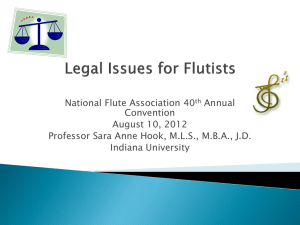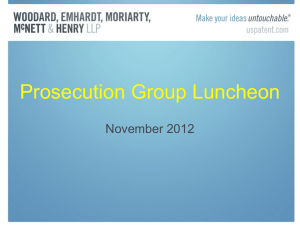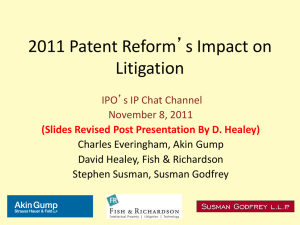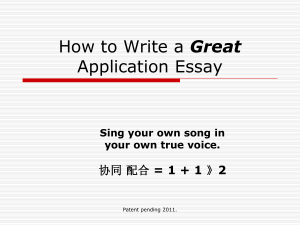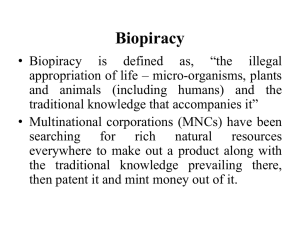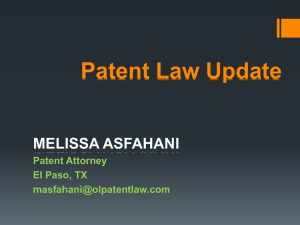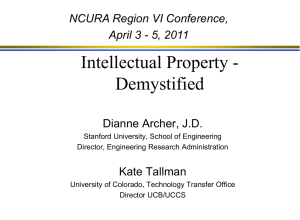Industry Standards
advertisement
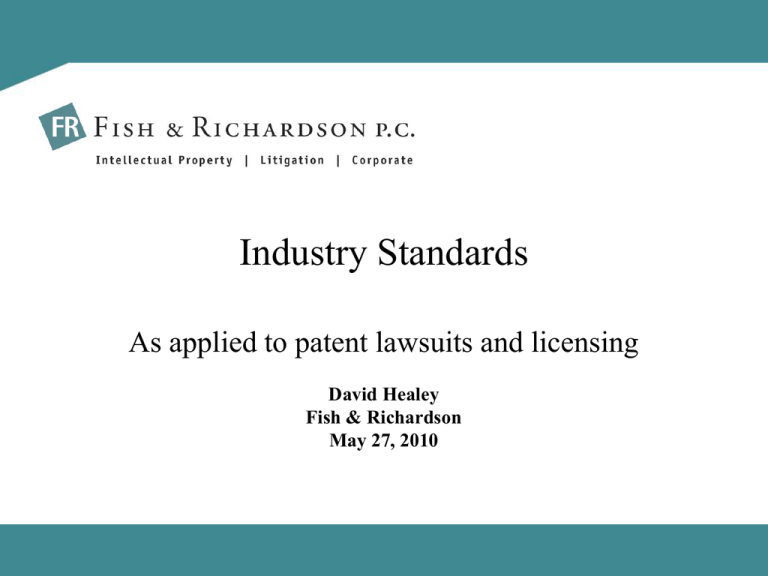
Industry Standards As applied to patent lawsuits and licensing David Healey Fish & Richardson May 27, 2010 Standard Setting Organizations 2 Types of Standards De Jure Standards: Standards or protocols adopted for compatibility or safety by an industry group, e.g., IEEE or JEDEC or ETSI De Facto Standards: Standards that have become adopted overtime by public popular demand, such as QWERTY keyboard Proprietary Standards: Standard created by a company that it does not license, such as power supply interface. This presentation is about De Jure Standards 3 Old U.S. Saying: “It is an enigma wrapped in a mystery.” – An “enigma” is something no one can ever understand: Like a force of nature. This “saying” means that we are dealing with a powerful force where the law is undefined. 4 Standard-Setting: Overview Standard-setting activity is an exception to U.S. antitrust laws: – Federal and State Laws prohibit competitors from working as a group to agree on technology they will use or on specifications of products they will sell. – Outside of the standard-setting exception these are FELONY CRIMES and also subject to CIVIL LIABILITY 5 PERMITTED: Standard-Setting has been permitted as an exception when: – It allows different manufacturers’ products to interface or interact with each other. – It provides for neutral certification of product safety 6 Compatibility=Competition Making different products from different manufacturers compatible with each other opens competition in closed systems to make more products available from more sellers: – Increases supply and availability – Increases innovation – Lowers price 7 Examples Example 1: – ETSI passes a standard protocol that allows different manufacturers’ GSM or WCDMA phones to connect to a GSM or WCDMA base station. – This standard allows all manufacturers to make GSM or WCDMA phones that are compatible with any other manufacturers’ GSM or WCDMA base station. – This is a proper use of standard-setting because it is for compatibility – This is legal 8 NOT PERMITTED: Generally, U.S. law DOES NOT permit standards to be set that do not enhance or improve product compatibility or certify safety: – Macaroni Makers Assoc v. FTC, 345 F.2d 421 (1965) is one example: Standards for noodles were declared illegal because noodles don’t have to be compatible and are safe. – Radiant Burners Inc v. Peoples Gas Light, 364 U.S. 656 (1961) is another example: Refusal to certify as safe an alternative meter to the only approved standard meter was illegal because the alternative was safe and the refusal to certify was to stop a competitor. – Allied Tube v Indian Head, 486 U.S. 492 (1988): Standard prohibiting use of rubber insulation on electrical wiring for homes was illegal because the manufacturers of other types of conduit “stacked” the vote to exclude rubber from the conduit standard to avoid competition from new manufacturers. 9 NOT PERMITTED: Standard-setting is not permitted: – To fix prices of any product or technology license. – To limit sale of technology or products – To fix price of technology to use in a standard 10 Example 2 ETSI passes a rule that all phones must have touch screens and music players. This has nothing to do with compatibility of the phones with a base station or the system. This is simply an agreement by competitors to only sell more expensive products with higher profit margins and not to sell cheaper products with lower profit margins. Under U.S. law this is a CRIME – A FELONY Under U.S. law this is also actionable by the FTC or a civil litigant as a civil antitrust violation Under EU law this is subject to fine by European Commission 11 The U.S. Supreme Court In every case the U.S. Supreme Court has had on standard-setting, it has ruled the law was broken. 12 Sources of Law U.S. Federal and State Antitrust law, – Title 15 of the U.S. Code, Section 1, Sherman Act prohibiting conspiracies in restraint of trade. – Title 15 of the U.S. Code, Section 45, FTC Act Section 5, prohibiting unfair competition – State antitrust and unfair competition laws on illegal group conduct – These laws over-ride any rules a standards group has made for itself: Compliance with a standard-setting group’s rules is not a defense! (But can be relevant fact in a case.) 13 Sources of Law U.S. patent law: – Equitable estoppel (non-disclosure or misleading disclosure) – Implied license (conduct that seems to permit use) – Patent misuse (hurting competition in a market with a patent on a standard by acting with others in selecting the standard and unfairly manipulating access to use of the standard) U.S. contract law: – Broadcomm v Qualcomm, 501 F.3d 297 (2007), established that the IP policy of a standards group is an enforceable contract among members 14 Sources of Law Europe – – – – Contract law Abusive pricing Duty of good faith Treaty of Rome, Articles 85 and 86 • Unfair competition and antitrust – National laws on unfair competition and trade practices 15 Sources of Law Taiwan FTC had a finding of anticompetitive conduct in licensing of DVD format for DVD disks KFTC? 16 The Beginning of Standards and IP – FTC v Dell Standards began in product safety. Standard-setting in IP begins with the FTC’s lawsuit in the early 1990s against Dell for failure to disclose to VESA that it had patents on a proposed VESA standard for compatibility of connections for computer monitors. Dell voted for the standard without disclosing its patents on the technology. Dell then sued industry competitors for patent infringement after the standard was implemented. FTC sued, and Dell promised not to enforce these patents against VESA standard or do this type of thing again. In re Dell, 121 F.T.C. 616 (1996) 17 Standards: Duty of Disclosure Anyone who participates in a standard-setting process must DISCLOSE known IP: – Stambler v Diebold, 878 F.2d 1445 (Fed. Cir. 1989), owner of patent knew standard-setting going on, did not participate, but did not speak up about patent, equitable estoppel – Mitsubishi v Wang, 103 F.3d 1571 (1997), owner of patent did not disclose patent issues when promoting its technology as de facto or de jure industry standard, implied license – In re Dell, 121 F.T.C. 616 (1996), owner of patent did not disclose patents when voting on standard, patent misuse/antitrust – Rambus v Infineon, 318 F.3d 1081 (2003), owner of patent must disclose under contract of standard’s group policy, but no money damages if the policy is not clear 18 Standards: Duty of Disclosure Today it is well-established that a patent owner who participates in creation or debate or a vote on a standard must disclose patents or other IP it thinks might be needed to implement the standard. The test is not whether the IP is actually needed, the test is whether the owner asserts it is needed: The purpose is to avoid allegations in a lawsuit not to decide actual claims. The patent owner who does not disclose is at risk that its patent is unenforceable against implementation of the standard. 19 DISCLOSURE!!! If you have a patent or published application you want to enforce, then you must disclose it in the standards process – 1) Disclose according to group’s rules – 2) Disclose at earliest opportunity – 3) Disclose directly to the working committee by email or letter before draft standard is sent for final vote by working committee regardless of the group’s rules. 20 DISCLOSURE!!! What if your patent application is not yet published anywhere? What if you are doing R&D and planning to apply for more patents in the future? DISCLOSURE: Write to the group president, the chairmen of the relevant working committees, prior to adoption of draft standards, that you have applied for IP in this area and are developing IP in this area going forward. DISCLOSURE: Make complete disclosure once publication occurs anywhere in the world. 21 THE IDS If you participate in standards groups, make sure you cite draft standards, standards, working papers, submissions from your company and other member companies to the PTO in your IDS. Disclose the material as art in patent offices Do Provisional Applications on new inventions before going to standards meetings 22 Duty to License Sources of law: – Mostly contract: The standard-setting group’s rules – U.S. and state antitrust laws on “essential facilities” and on exclusion of competitors from markets – State contract law on “promissory estoppel” – Europe: Compulsory licenses have been ordered 23 Can YOU AVOID Duty to License? YES, but to avoid or limit duty to license: Disclose clearly at all relevant times and broadly to all interested players and to the members and the officers of the standards’ group that you will not license IP you think is needed for implementation of a standard (or disclose terms you will insist upon in any license). Disclose to the working committee members and its chairman that you will not license IP needed for the draft standard before the draft standard is so far along in development that investment has been made in product design by industry players Post on your website in your standards policy that you may choose not to license or insist on certain terms. 24 Duty to License Common to both US and EU law is that a commitment to license in a standard-setting group’s rules is enforceable by members against each other… BUT WHAT DOES THIS MEAN? 25 Duty to License Most standards’ groups rules are not as clear as private contracts Generally: – In Europe, laws against abusive pricing apply to keep royalties lower than can be argued in the US where no such laws exist – In US, language in IP policies that is vague will be argued by one side or the other to get what it wants in the end: no restriction on price or some restriction on price – The preferred result is that the patent owner should get the same aggregate amount of royalties or profits it would have received from licensing if NO STANDARD had been adopted at all. – This means royalty should consider scale or volume added to royalty base by the group’s adoption of the standard so as not to inflate value of patent due to group action. – This also means that royalty amount should not be less than what would have been collected had no group action occurred. 26 Duty to License Injunction issue is unresolved: 1) Nokia v Apple (Del.) sued for royalty only for patents disclosed in standards 2) Samsung in ITC against IDC had said that so long as it had made a fair and non-discriminatory offer, then no injunction could issue until Court decided if the amount of the royalty offered fulfilled its obligation 3) In Ericsson v Samsung, District Court bifurcated to try the royalty issue first for standards patents before liability or other parts of case to decide if license existed under group rules and only price in dispute 4) Nokia had taken position in the past that it only had to license specific patents used in standard not the portfolio disclosed for the standard by the patent owner (or even just specific claims of a patent) 5) Samsung had taken position in the past portfolio disclosed for the standard by the patent owner and any other patent that could be asserted against standard would be licensed and extent of use and value is part of price 6) Samsung has said no injunction can be sought before a fair and nondiscriminatory offer has been made, but court need not rule on that issue before an injunction is requested. 27 Example 3 There are 4 proposed standard interfaces for a power supply and a laptop. You have a patent on one of the 4 proposed standard interfaces. Since the patent issued you have licensed the patent to 40% of the manufacturers for a royalty of $0.50 per laptop. No other licenses have been made or requested. Your patent is adopted as the standard, your royalty might be: 1) No more than $0.50 less $0.20 to account for larger base; 2) for a new royalty of $0.30 per laptop. 28 Example 4 There is only one way that a protocol for a standard interface circuit for a power supply that works in all countries on all electrical outlets and electrical systems can be implemented and no other way. You have a patent on this single viable method. Your patented method is proposed as a standard interface circuit. Since the patent issued you have licensed the patent to 50% of the manufacturers for a royalty of $1.00 per laptop that uses the protocol. Your patent is adopted as the standard, your royalty should remain at $1.00 for each laptop that uses the protocol because there are no alternatives to your patent. 29 Litigation Tactics – As Plaintiff DO NOT assert a patent against a standard unless the patent was disclosed in the standard-setting process as required by the group’s rules. DO NOT assert a patent against a standard unless the record is clear that the patent application was filed before or independently of work by a group on a standard. BEFORE SUIT, offer to license a patent you declared relevant to a standard on fair and non-discriminatory terms. BEFORE SUIT, collect all documents related to the standard and compliance with the group’s policy for disclosure and licensing – and make sure you complied! 30 Litigation Tactics -- Plaintiff ITC is best forum for plaintiff on industry standards issue because the ALJs focus on patent issues for exclusion orders not contract issues between parties. The idea of a compulsory license contradicts idea of an exclusion order. The ITC cannot decide contract and antitrust claims. But if you want money, go to district court first and file as a patent infringement suit not a contract or antitrust case because: – The Federal Circuit is hostile to compulsory license, standards and antitrust claims, and filing as a patent case ensures Federal Circuit jurisdiction on appeal. – You can avoid contradictory positions by not seeking injunctive relief in district court on standards patents – You can seek injunctive relief on patents that do not relate to standards – Choice of law is important due to European laws against abusive pricing as a limiting factor on any license. 31 Litigation Tactics -- Defendant Checklist if patent is asserted against a standard: 1) Was patent or application disclosed properly and timely in the process? 2) How and when was it disclosed (in accord with the rules of the group or not)? 3) What are the group’s rules on IP disclosure and licensing? 4) Were disclosure and licensing rules followed? 5) Why did the committee choose the standard despite the patent disclosure – were promises or assurances made on licensing to working committee members or group? 6) Were people who voted on the standard employed by companies already cross-licensed so that the standard advantaged them but hurt others due to patent? 7) What positions has the patent owner taken in the past on injunctions and royalties on standards? 32 Litigation Tactics -- Defendant Checklist if patent is asserted against standard (continued): 8) Does the standards group have a legal or licensing committee where statements were made relevant to royalties? E.g., UMTS legal committee had discussions of aggregate royalty per phone. 9) What is the evidence of the total amount of royalties that the patent owner would have collected if the patent was not picked as the standard? (The “ex ante” lost license fee) 10) Would the license price and terms offered make it costly or difficult to manufacture the product? (that is contradict purpose of exception to antitrust law – make goods cheaper and supply bigger) 11) Could a cheaper alternative technology have been chosen instead had committee members known of the patent or the license terms? 12) Can products be marketed and sold without compliance with the standard? E.g., is it a protocol for a cell phone to connect to a base station. 13) What country’s law applies to the IP policy? E.g., ETSI is France 14) Did the patent owner promote its IP as a standard and imply it would freely and cheaply license? Or make other representations on licensing? 15) Did patent owner disclose to PTO any relevant art or submissions it learned of in the standards group related to its application? 33 Defenses and Counterclaims Defenses – Equitable estoppel: failure to disclose or misleading or incomplete disclosure – Implied license: People lead to believe they could use IP in the standard with no fee – Patent misuse: Patent covers (or blocks) implementation of the standard; neither the product nor alternatives can be sold without the standard; the patent owner is charging too much, or tying the patent license to a license to other patents not desired by the licensee, or demanding a free grant-back on your patents as a condition of the license. – Inequitable conduct: The patent owner did not disclose art from the standards group to the PTO prior to issuance of the patent. – Abusive pricing under European law if applicable 34 Defenses and Counterclaims Breach of contract: Failure to license as promised by joining the group and adopting its rules (contract). Promissory estoppel: Patentee is barred from denying a contractual license exists due to its conduct in the group. Unfair competition: The patent owner has done something that violates another law or is an unfair business practice to hurt competition. (Mass Gen Laws. Chap. 93A, Texas common law) Antitrust: The patentee and one or more members of the group have conspired to manipulate the standard to hurt other competitors or gain an advantage in the market. Fraud: The patentee failed to disclose or lied about its IP or its coverage or terms for license. (Negligent misrepresentation may also apply). 35

